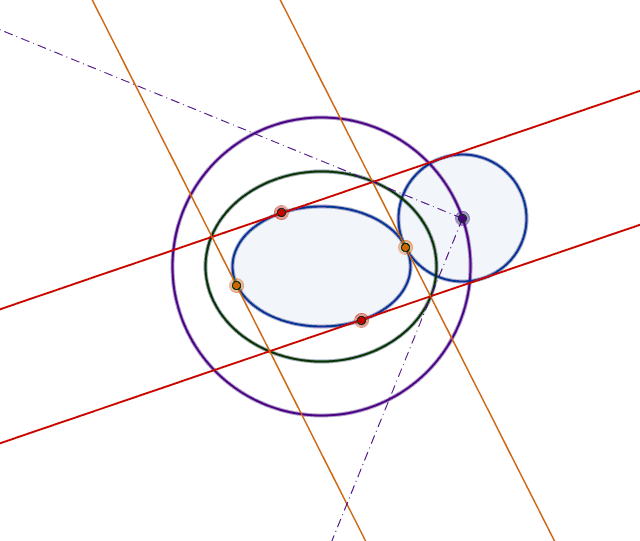A circle tangent to an ellipse
Solution 1:
I have a roadmap for a simple solution through analytic geometry / trigonometry:
- Let us consider an ellipse $\mathcal{E}$ with equation $\frac{x^2}{a^2}+\frac{y^2}{b^2}=1$, i.e. $(x,y)=(a\cos\theta,b\sin\theta)$;
- Let us consider a generic point $P\in\mathcal{E}$, i.e. some $\theta\in[0,2\pi)$;
- Let us compute the slope of the tangent $\tau_{P}$ through $P$ and consider that the parallel tangent is $\tau_{-P}$, since in a conic the midpoints of parallel chords are aligned along a line through the center of the conic;
- Let $R_\theta$ be half the distance between $\tau_P$ and $\tau_{-P}$ and $\ell_\theta$ the line through the original parallel to $\tau_P$. Let $C_\theta$ be an intersection between $\ell_\theta$ and the circle $x^2+y^2=(a+b)^2$;
- In order to check that $\mathcal{E}$ and the circle with radius $R_\theta$ centered at $C_\theta$ are tangent it is enough to check that a discriminant equals zero.

Here there are some ideas for a purely Euclidean solution:
- Let $Q=\mathcal{C}\cap\mathcal{E}$. First Claim: the parallelogram having sides $\tau_P,\tau_{-P},\tau_Q,\tau_{-Q}$ has its vertices on a fixed ellipse $\mathcal{E}'$, having the same foci as $\mathcal{E}$;
- Let $U,V$ the vertices of the previous parallelogram on $\tau_Q$. Second Claim: $C_\theta U$ and $C_\theta V$ are orthogonal tangents to $\mathcal{E}'$, so $C_\theta$ lies on the orthoptic of $\mathcal{E}'$ and has a constant distance from $O$.

Indeed, the first claim follows from Poncelet's porism and the second claim is just a matter of angle chasing.
Here it comes an animation, too:
